Project: South Africa Exchange Rate Volatility and Gold Mining Sector
VerifiedAdded on 2020/04/13
|9
|1785
|48
Project
AI Summary
This project investigates the impact of exchange rate volatility on the gold mining sector's share prices in South Africa. The research explores the background of exchange rate fluctuations and their effects on the economy, particularly the gold mining sector, a significant export industry for South Africa. The study examines the research problem, rationale, purpose, and research questions, including the role of capital account liberalization. A literature review provides context, and the research methodology outlines the descriptive design, data collection from secondary sources, and thematic data analysis. Ethical considerations in the research process are also addressed. The project aims to help policymakers understand and mitigate the negative impacts of exchange rate volatility on the gold mining sector, ultimately improving the sector's performance and share prices.
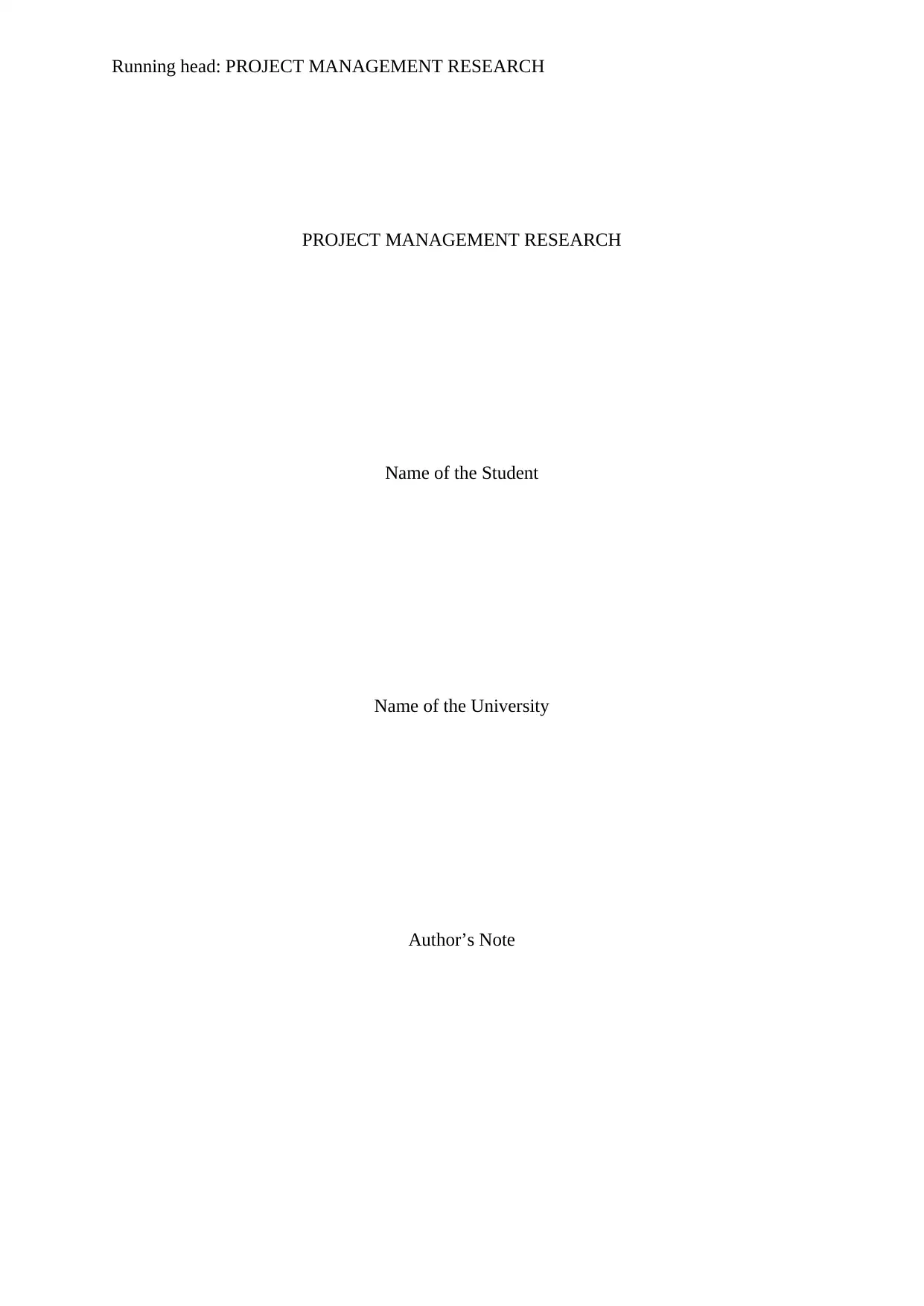
Running head: PROJECT MANAGEMENT RESEARCH
PROJECT MANAGEMENT RESEARCH
Name of the Student
Name of the University
Author’s Note
PROJECT MANAGEMENT RESEARCH
Name of the Student
Name of the University
Author’s Note
Paraphrase This Document
Need a fresh take? Get an instant paraphrase of this document with our AI Paraphraser
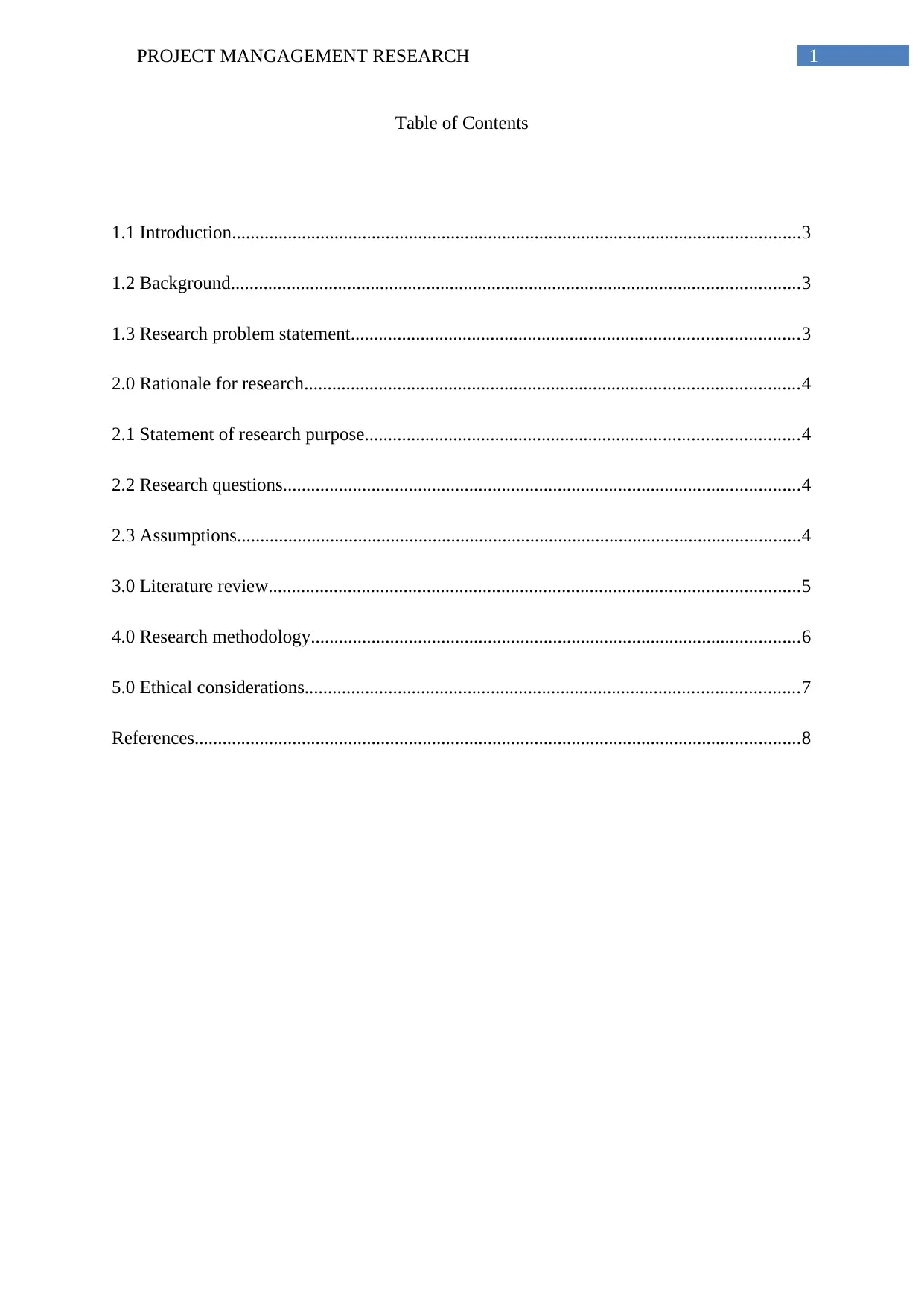
1PROJECT MANGAGEMENT RESEARCH
Table of Contents
1.1 Introduction..........................................................................................................................3
1.2 Background..........................................................................................................................3
1.3 Research problem statement................................................................................................3
2.0 Rationale for research..........................................................................................................4
2.1 Statement of research purpose.............................................................................................4
2.2 Research questions...............................................................................................................4
2.3 Assumptions.........................................................................................................................4
3.0 Literature review..................................................................................................................5
4.0 Research methodology.........................................................................................................6
5.0 Ethical considerations..........................................................................................................7
References..................................................................................................................................8
Table of Contents
1.1 Introduction..........................................................................................................................3
1.2 Background..........................................................................................................................3
1.3 Research problem statement................................................................................................3
2.0 Rationale for research..........................................................................................................4
2.1 Statement of research purpose.............................................................................................4
2.2 Research questions...............................................................................................................4
2.3 Assumptions.........................................................................................................................4
3.0 Literature review..................................................................................................................5
4.0 Research methodology.........................................................................................................6
5.0 Ethical considerations..........................................................................................................7
References..................................................................................................................................8
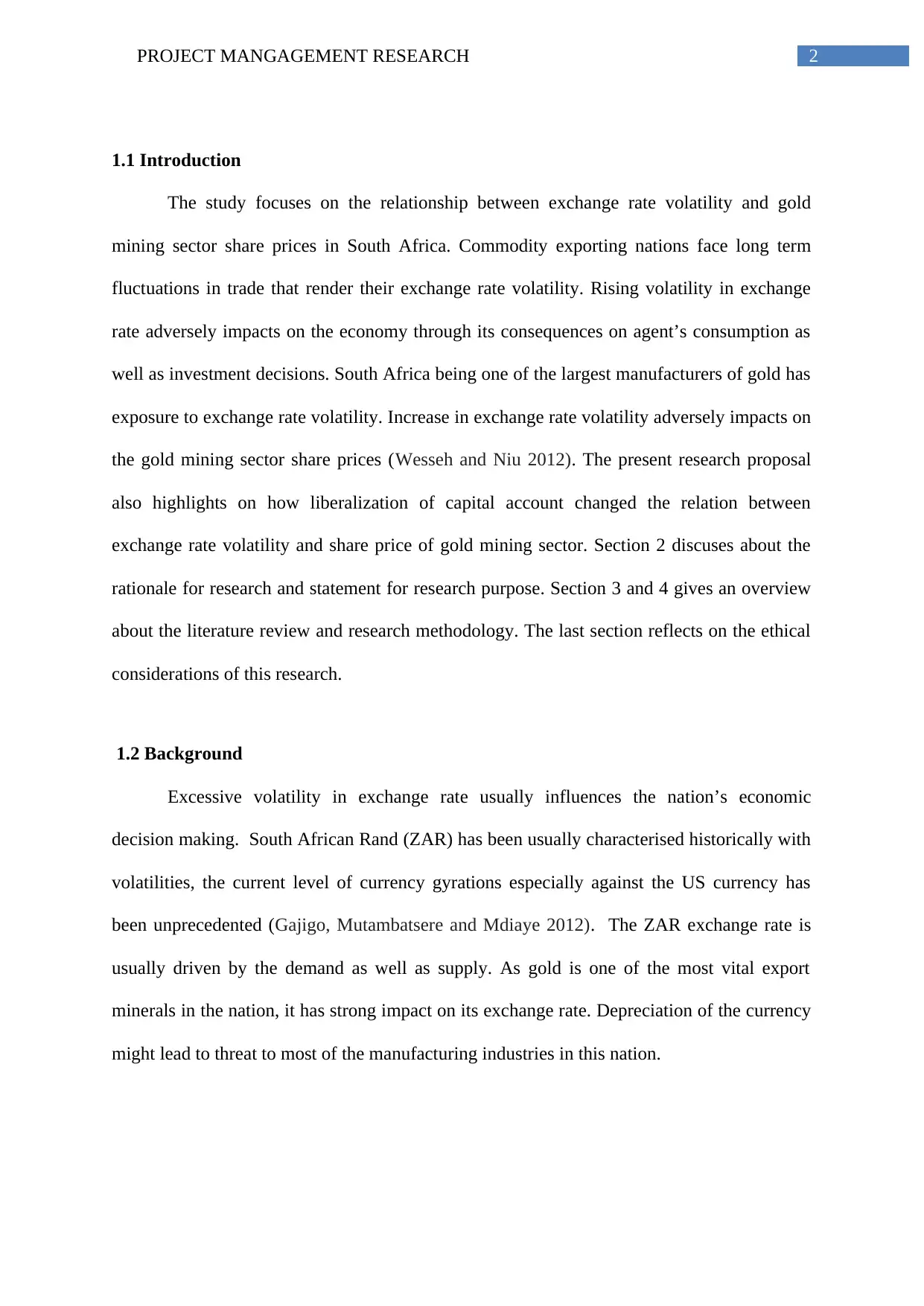
2PROJECT MANGAGEMENT RESEARCH
1.1 Introduction
The study focuses on the relationship between exchange rate volatility and gold
mining sector share prices in South Africa. Commodity exporting nations face long term
fluctuations in trade that render their exchange rate volatility. Rising volatility in exchange
rate adversely impacts on the economy through its consequences on agent’s consumption as
well as investment decisions. South Africa being one of the largest manufacturers of gold has
exposure to exchange rate volatility. Increase in exchange rate volatility adversely impacts on
the gold mining sector share prices (Wesseh and Niu 2012). The present research proposal
also highlights on how liberalization of capital account changed the relation between
exchange rate volatility and share price of gold mining sector. Section 2 discuses about the
rationale for research and statement for research purpose. Section 3 and 4 gives an overview
about the literature review and research methodology. The last section reflects on the ethical
considerations of this research.
1.2 Background
Excessive volatility in exchange rate usually influences the nation’s economic
decision making. South African Rand (ZAR) has been usually characterised historically with
volatilities, the current level of currency gyrations especially against the US currency has
been unprecedented (Gajigo, Mutambatsere and Mdiaye 2012). The ZAR exchange rate is
usually driven by the demand as well as supply. As gold is one of the most vital export
minerals in the nation, it has strong impact on its exchange rate. Depreciation of the currency
might lead to threat to most of the manufacturing industries in this nation.
1.1 Introduction
The study focuses on the relationship between exchange rate volatility and gold
mining sector share prices in South Africa. Commodity exporting nations face long term
fluctuations in trade that render their exchange rate volatility. Rising volatility in exchange
rate adversely impacts on the economy through its consequences on agent’s consumption as
well as investment decisions. South Africa being one of the largest manufacturers of gold has
exposure to exchange rate volatility. Increase in exchange rate volatility adversely impacts on
the gold mining sector share prices (Wesseh and Niu 2012). The present research proposal
also highlights on how liberalization of capital account changed the relation between
exchange rate volatility and share price of gold mining sector. Section 2 discuses about the
rationale for research and statement for research purpose. Section 3 and 4 gives an overview
about the literature review and research methodology. The last section reflects on the ethical
considerations of this research.
1.2 Background
Excessive volatility in exchange rate usually influences the nation’s economic
decision making. South African Rand (ZAR) has been usually characterised historically with
volatilities, the current level of currency gyrations especially against the US currency has
been unprecedented (Gajigo, Mutambatsere and Mdiaye 2012). The ZAR exchange rate is
usually driven by the demand as well as supply. As gold is one of the most vital export
minerals in the nation, it has strong impact on its exchange rate. Depreciation of the currency
might lead to threat to most of the manufacturing industries in this nation.
⊘ This is a preview!⊘
Do you want full access?
Subscribe today to unlock all pages.

Trusted by 1+ million students worldwide
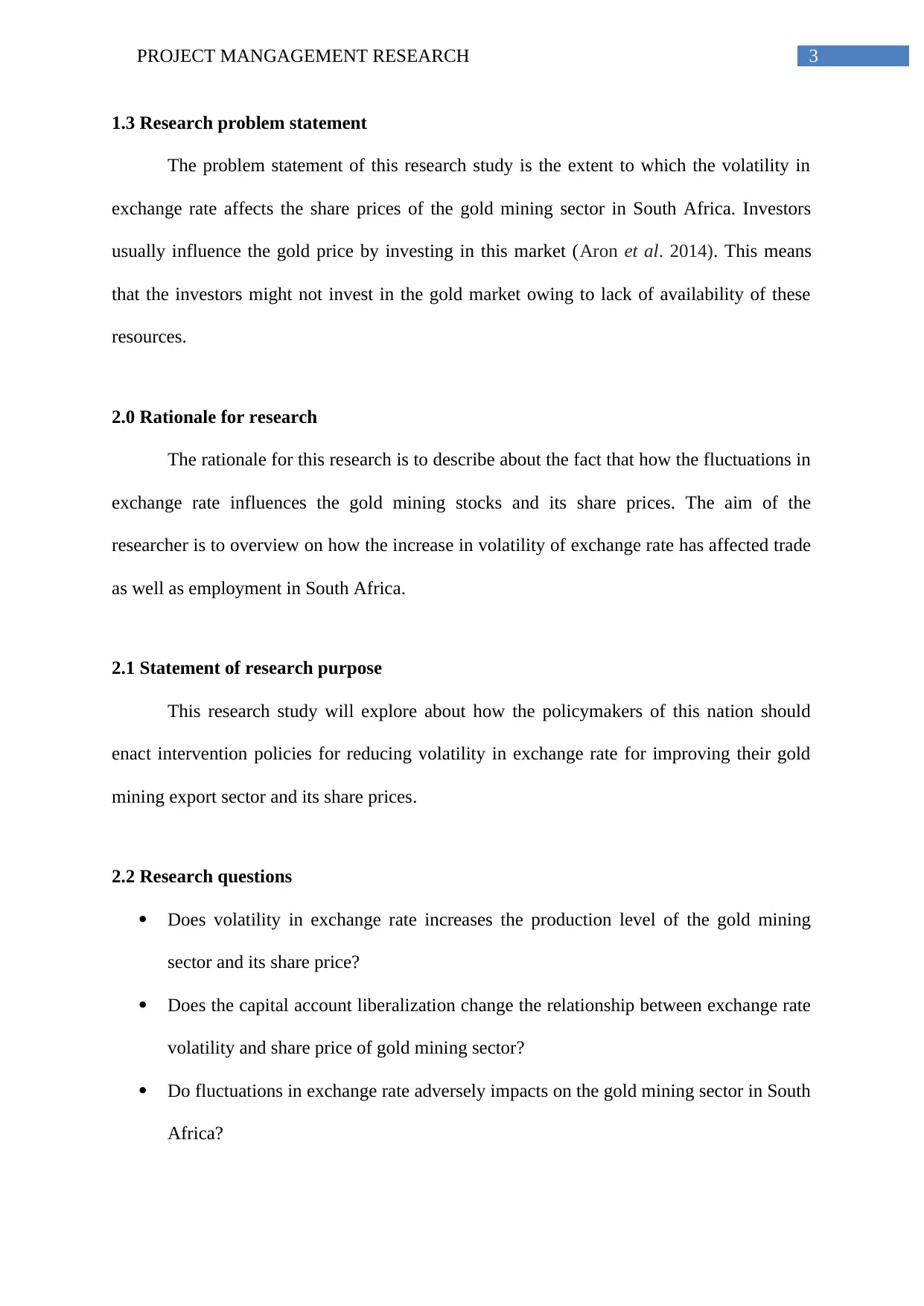
3PROJECT MANGAGEMENT RESEARCH
1.3 Research problem statement
The problem statement of this research study is the extent to which the volatility in
exchange rate affects the share prices of the gold mining sector in South Africa. Investors
usually influence the gold price by investing in this market (Aron et al. 2014). This means
that the investors might not invest in the gold market owing to lack of availability of these
resources.
2.0 Rationale for research
The rationale for this research is to describe about the fact that how the fluctuations in
exchange rate influences the gold mining stocks and its share prices. The aim of the
researcher is to overview on how the increase in volatility of exchange rate has affected trade
as well as employment in South Africa.
2.1 Statement of research purpose
This research study will explore about how the policymakers of this nation should
enact intervention policies for reducing volatility in exchange rate for improving their gold
mining export sector and its share prices.
2.2 Research questions
Does volatility in exchange rate increases the production level of the gold mining
sector and its share price?
Does the capital account liberalization change the relationship between exchange rate
volatility and share price of gold mining sector?
Do fluctuations in exchange rate adversely impacts on the gold mining sector in South
Africa?
1.3 Research problem statement
The problem statement of this research study is the extent to which the volatility in
exchange rate affects the share prices of the gold mining sector in South Africa. Investors
usually influence the gold price by investing in this market (Aron et al. 2014). This means
that the investors might not invest in the gold market owing to lack of availability of these
resources.
2.0 Rationale for research
The rationale for this research is to describe about the fact that how the fluctuations in
exchange rate influences the gold mining stocks and its share prices. The aim of the
researcher is to overview on how the increase in volatility of exchange rate has affected trade
as well as employment in South Africa.
2.1 Statement of research purpose
This research study will explore about how the policymakers of this nation should
enact intervention policies for reducing volatility in exchange rate for improving their gold
mining export sector and its share prices.
2.2 Research questions
Does volatility in exchange rate increases the production level of the gold mining
sector and its share price?
Does the capital account liberalization change the relationship between exchange rate
volatility and share price of gold mining sector?
Do fluctuations in exchange rate adversely impacts on the gold mining sector in South
Africa?
Paraphrase This Document
Need a fresh take? Get an instant paraphrase of this document with our AI Paraphraser
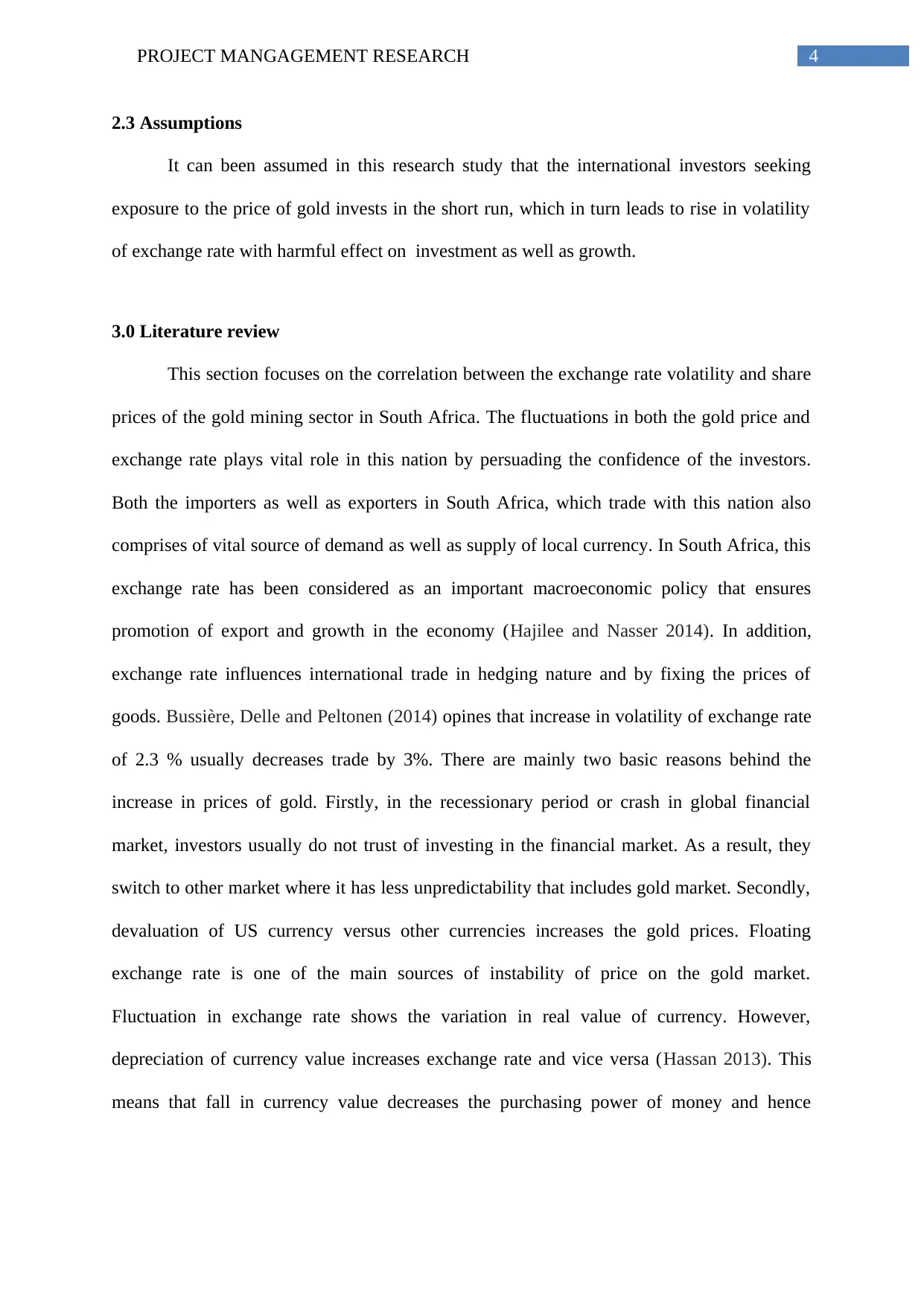
4PROJECT MANGAGEMENT RESEARCH
2.3 Assumptions
It can been assumed in this research study that the international investors seeking
exposure to the price of gold invests in the short run, which in turn leads to rise in volatility
of exchange rate with harmful effect on investment as well as growth.
3.0 Literature review
This section focuses on the correlation between the exchange rate volatility and share
prices of the gold mining sector in South Africa. The fluctuations in both the gold price and
exchange rate plays vital role in this nation by persuading the confidence of the investors.
Both the importers as well as exporters in South Africa, which trade with this nation also
comprises of vital source of demand as well as supply of local currency. In South Africa, this
exchange rate has been considered as an important macroeconomic policy that ensures
promotion of export and growth in the economy (Hajilee and Nasser 2014). In addition,
exchange rate influences international trade in hedging nature and by fixing the prices of
goods. Bussière, Delle and Peltonen (2014) opines that increase in volatility of exchange rate
of 2.3 % usually decreases trade by 3%. There are mainly two basic reasons behind the
increase in prices of gold. Firstly, in the recessionary period or crash in global financial
market, investors usually do not trust of investing in the financial market. As a result, they
switch to other market where it has less unpredictability that includes gold market. Secondly,
devaluation of US currency versus other currencies increases the gold prices. Floating
exchange rate is one of the main sources of instability of price on the gold market.
Fluctuation in exchange rate shows the variation in real value of currency. However,
depreciation of currency value increases exchange rate and vice versa (Hassan 2013). This
means that fall in currency value decreases the purchasing power of money and hence
2.3 Assumptions
It can been assumed in this research study that the international investors seeking
exposure to the price of gold invests in the short run, which in turn leads to rise in volatility
of exchange rate with harmful effect on investment as well as growth.
3.0 Literature review
This section focuses on the correlation between the exchange rate volatility and share
prices of the gold mining sector in South Africa. The fluctuations in both the gold price and
exchange rate plays vital role in this nation by persuading the confidence of the investors.
Both the importers as well as exporters in South Africa, which trade with this nation also
comprises of vital source of demand as well as supply of local currency. In South Africa, this
exchange rate has been considered as an important macroeconomic policy that ensures
promotion of export and growth in the economy (Hajilee and Nasser 2014). In addition,
exchange rate influences international trade in hedging nature and by fixing the prices of
goods. Bussière, Delle and Peltonen (2014) opines that increase in volatility of exchange rate
of 2.3 % usually decreases trade by 3%. There are mainly two basic reasons behind the
increase in prices of gold. Firstly, in the recessionary period or crash in global financial
market, investors usually do not trust of investing in the financial market. As a result, they
switch to other market where it has less unpredictability that includes gold market. Secondly,
devaluation of US currency versus other currencies increases the gold prices. Floating
exchange rate is one of the main sources of instability of price on the gold market.
Fluctuation in exchange rate shows the variation in real value of currency. However,
depreciation of currency value increases exchange rate and vice versa (Hassan 2013). This
means that fall in currency value decreases the purchasing power of money and hence
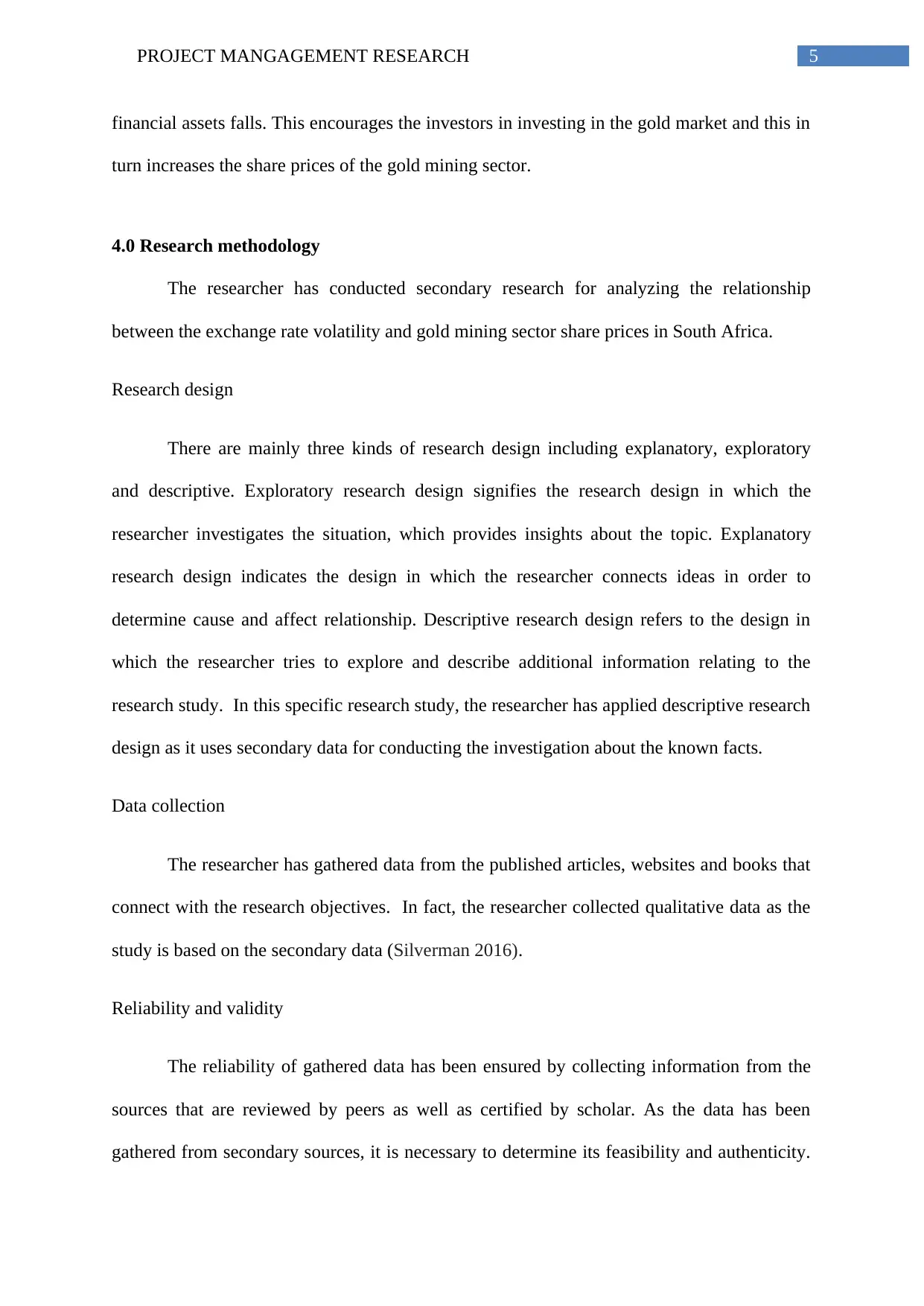
5PROJECT MANGAGEMENT RESEARCH
financial assets falls. This encourages the investors in investing in the gold market and this in
turn increases the share prices of the gold mining sector.
4.0 Research methodology
The researcher has conducted secondary research for analyzing the relationship
between the exchange rate volatility and gold mining sector share prices in South Africa.
Research design
There are mainly three kinds of research design including explanatory, exploratory
and descriptive. Exploratory research design signifies the research design in which the
researcher investigates the situation, which provides insights about the topic. Explanatory
research design indicates the design in which the researcher connects ideas in order to
determine cause and affect relationship. Descriptive research design refers to the design in
which the researcher tries to explore and describe additional information relating to the
research study. In this specific research study, the researcher has applied descriptive research
design as it uses secondary data for conducting the investigation about the known facts.
Data collection
The researcher has gathered data from the published articles, websites and books that
connect with the research objectives. In fact, the researcher collected qualitative data as the
study is based on the secondary data (Silverman 2016).
Reliability and validity
The reliability of gathered data has been ensured by collecting information from the
sources that are reviewed by peers as well as certified by scholar. As the data has been
gathered from secondary sources, it is necessary to determine its feasibility and authenticity.
financial assets falls. This encourages the investors in investing in the gold market and this in
turn increases the share prices of the gold mining sector.
4.0 Research methodology
The researcher has conducted secondary research for analyzing the relationship
between the exchange rate volatility and gold mining sector share prices in South Africa.
Research design
There are mainly three kinds of research design including explanatory, exploratory
and descriptive. Exploratory research design signifies the research design in which the
researcher investigates the situation, which provides insights about the topic. Explanatory
research design indicates the design in which the researcher connects ideas in order to
determine cause and affect relationship. Descriptive research design refers to the design in
which the researcher tries to explore and describe additional information relating to the
research study. In this specific research study, the researcher has applied descriptive research
design as it uses secondary data for conducting the investigation about the known facts.
Data collection
The researcher has gathered data from the published articles, websites and books that
connect with the research objectives. In fact, the researcher collected qualitative data as the
study is based on the secondary data (Silverman 2016).
Reliability and validity
The reliability of gathered data has been ensured by collecting information from the
sources that are reviewed by peers as well as certified by scholar. As the data has been
gathered from secondary sources, it is necessary to determine its feasibility and authenticity.
⊘ This is a preview!⊘
Do you want full access?
Subscribe today to unlock all pages.

Trusted by 1+ million students worldwide
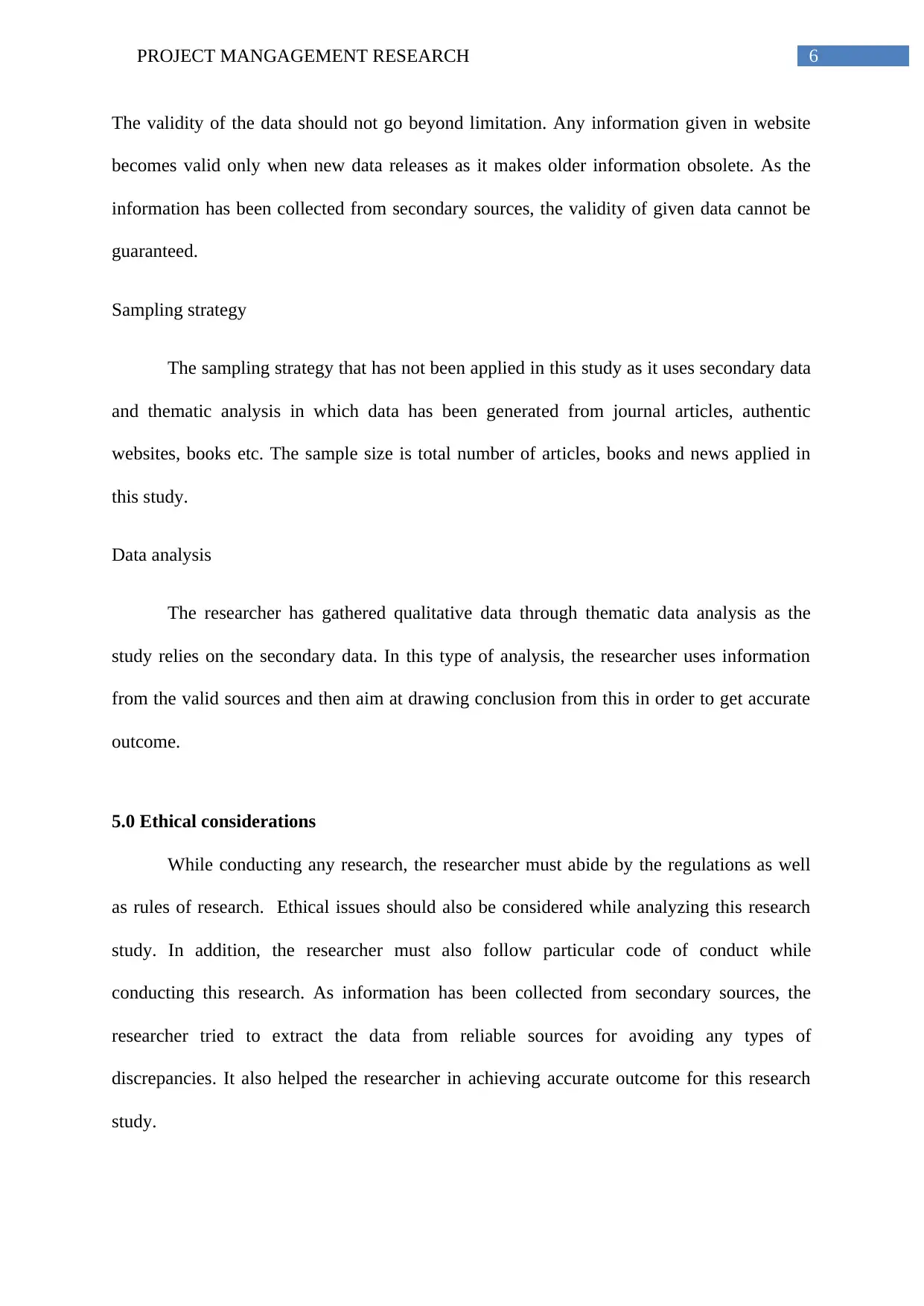
6PROJECT MANGAGEMENT RESEARCH
The validity of the data should not go beyond limitation. Any information given in website
becomes valid only when new data releases as it makes older information obsolete. As the
information has been collected from secondary sources, the validity of given data cannot be
guaranteed.
Sampling strategy
The sampling strategy that has not been applied in this study as it uses secondary data
and thematic analysis in which data has been generated from journal articles, authentic
websites, books etc. The sample size is total number of articles, books and news applied in
this study.
Data analysis
The researcher has gathered qualitative data through thematic data analysis as the
study relies on the secondary data. In this type of analysis, the researcher uses information
from the valid sources and then aim at drawing conclusion from this in order to get accurate
outcome.
5.0 Ethical considerations
While conducting any research, the researcher must abide by the regulations as well
as rules of research. Ethical issues should also be considered while analyzing this research
study. In addition, the researcher must also follow particular code of conduct while
conducting this research. As information has been collected from secondary sources, the
researcher tried to extract the data from reliable sources for avoiding any types of
discrepancies. It also helped the researcher in achieving accurate outcome for this research
study.
The validity of the data should not go beyond limitation. Any information given in website
becomes valid only when new data releases as it makes older information obsolete. As the
information has been collected from secondary sources, the validity of given data cannot be
guaranteed.
Sampling strategy
The sampling strategy that has not been applied in this study as it uses secondary data
and thematic analysis in which data has been generated from journal articles, authentic
websites, books etc. The sample size is total number of articles, books and news applied in
this study.
Data analysis
The researcher has gathered qualitative data through thematic data analysis as the
study relies on the secondary data. In this type of analysis, the researcher uses information
from the valid sources and then aim at drawing conclusion from this in order to get accurate
outcome.
5.0 Ethical considerations
While conducting any research, the researcher must abide by the regulations as well
as rules of research. Ethical issues should also be considered while analyzing this research
study. In addition, the researcher must also follow particular code of conduct while
conducting this research. As information has been collected from secondary sources, the
researcher tried to extract the data from reliable sources for avoiding any types of
discrepancies. It also helped the researcher in achieving accurate outcome for this research
study.
Paraphrase This Document
Need a fresh take? Get an instant paraphrase of this document with our AI Paraphraser
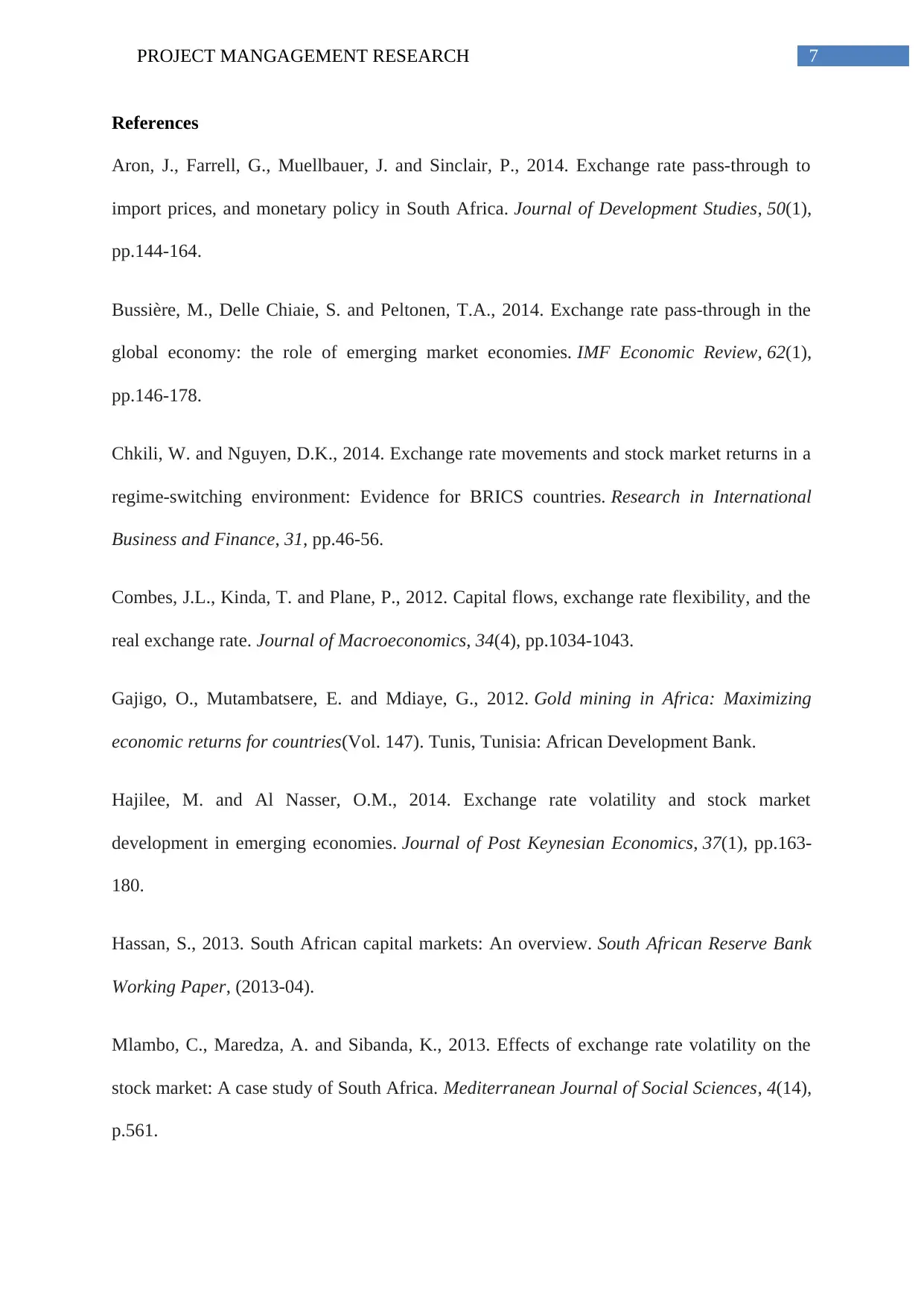
7PROJECT MANGAGEMENT RESEARCH
References
Aron, J., Farrell, G., Muellbauer, J. and Sinclair, P., 2014. Exchange rate pass-through to
import prices, and monetary policy in South Africa. Journal of Development Studies, 50(1),
pp.144-164.
Bussière, M., Delle Chiaie, S. and Peltonen, T.A., 2014. Exchange rate pass-through in the
global economy: the role of emerging market economies. IMF Economic Review, 62(1),
pp.146-178.
Chkili, W. and Nguyen, D.K., 2014. Exchange rate movements and stock market returns in a
regime-switching environment: Evidence for BRICS countries. Research in International
Business and Finance, 31, pp.46-56.
Combes, J.L., Kinda, T. and Plane, P., 2012. Capital flows, exchange rate flexibility, and the
real exchange rate. Journal of Macroeconomics, 34(4), pp.1034-1043.
Gajigo, O., Mutambatsere, E. and Mdiaye, G., 2012. Gold mining in Africa: Maximizing
economic returns for countries(Vol. 147). Tunis, Tunisia: African Development Bank.
Hajilee, M. and Al Nasser, O.M., 2014. Exchange rate volatility and stock market
development in emerging economies. Journal of Post Keynesian Economics, 37(1), pp.163-
180.
Hassan, S., 2013. South African capital markets: An overview. South African Reserve Bank
Working Paper, (2013-04).
Mlambo, C., Maredza, A. and Sibanda, K., 2013. Effects of exchange rate volatility on the
stock market: A case study of South Africa. Mediterranean Journal of Social Sciences, 4(14),
p.561.
References
Aron, J., Farrell, G., Muellbauer, J. and Sinclair, P., 2014. Exchange rate pass-through to
import prices, and monetary policy in South Africa. Journal of Development Studies, 50(1),
pp.144-164.
Bussière, M., Delle Chiaie, S. and Peltonen, T.A., 2014. Exchange rate pass-through in the
global economy: the role of emerging market economies. IMF Economic Review, 62(1),
pp.146-178.
Chkili, W. and Nguyen, D.K., 2014. Exchange rate movements and stock market returns in a
regime-switching environment: Evidence for BRICS countries. Research in International
Business and Finance, 31, pp.46-56.
Combes, J.L., Kinda, T. and Plane, P., 2012. Capital flows, exchange rate flexibility, and the
real exchange rate. Journal of Macroeconomics, 34(4), pp.1034-1043.
Gajigo, O., Mutambatsere, E. and Mdiaye, G., 2012. Gold mining in Africa: Maximizing
economic returns for countries(Vol. 147). Tunis, Tunisia: African Development Bank.
Hajilee, M. and Al Nasser, O.M., 2014. Exchange rate volatility and stock market
development in emerging economies. Journal of Post Keynesian Economics, 37(1), pp.163-
180.
Hassan, S., 2013. South African capital markets: An overview. South African Reserve Bank
Working Paper, (2013-04).
Mlambo, C., Maredza, A. and Sibanda, K., 2013. Effects of exchange rate volatility on the
stock market: A case study of South Africa. Mediterranean Journal of Social Sciences, 4(14),
p.561.
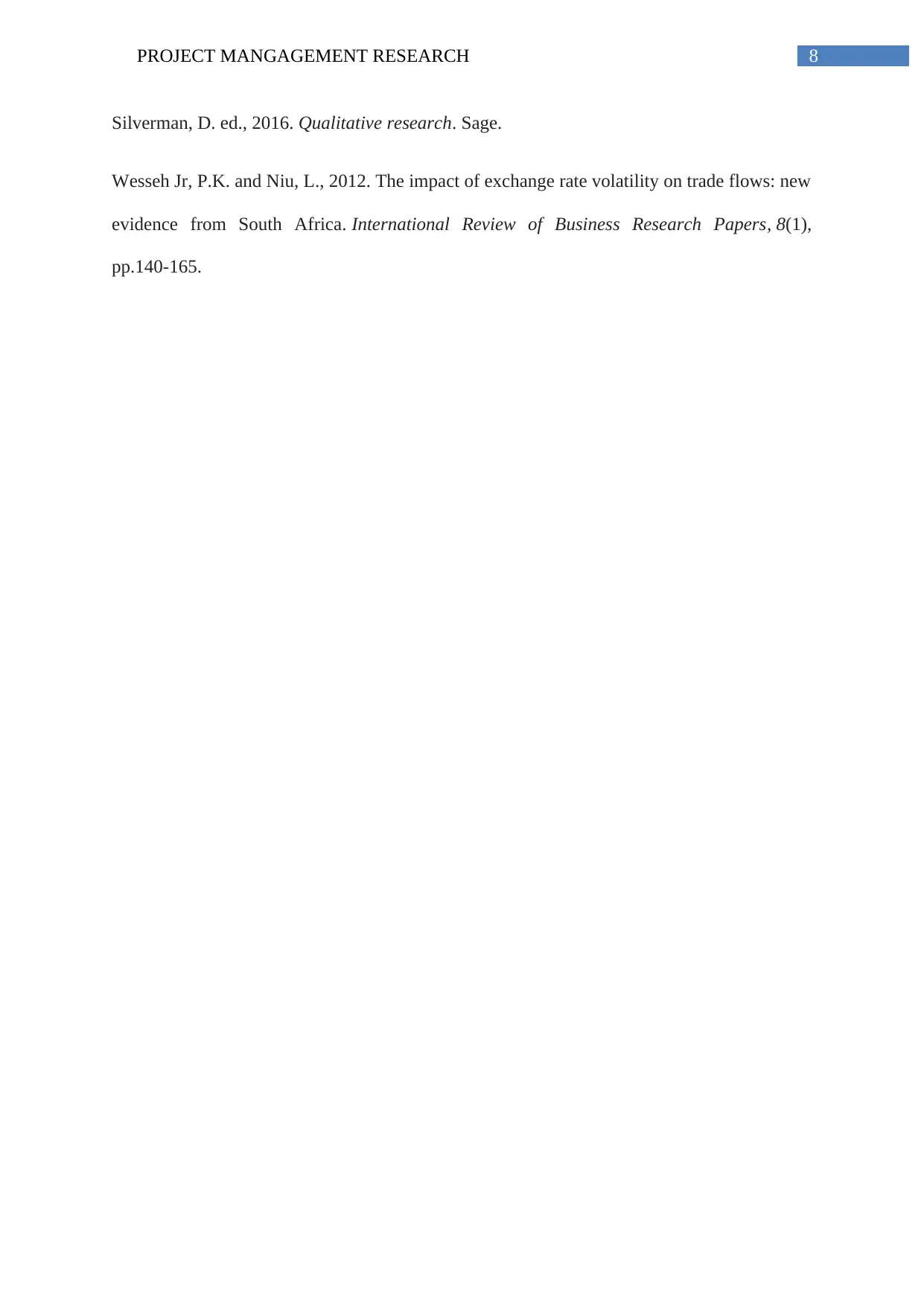
8PROJECT MANGAGEMENT RESEARCH
Silverman, D. ed., 2016. Qualitative research. Sage.
Wesseh Jr, P.K. and Niu, L., 2012. The impact of exchange rate volatility on trade flows: new
evidence from South Africa. International Review of Business Research Papers, 8(1),
pp.140-165.
Silverman, D. ed., 2016. Qualitative research. Sage.
Wesseh Jr, P.K. and Niu, L., 2012. The impact of exchange rate volatility on trade flows: new
evidence from South Africa. International Review of Business Research Papers, 8(1),
pp.140-165.
⊘ This is a preview!⊘
Do you want full access?
Subscribe today to unlock all pages.

Trusted by 1+ million students worldwide
1 out of 9
Related Documents
Your All-in-One AI-Powered Toolkit for Academic Success.
+13062052269
info@desklib.com
Available 24*7 on WhatsApp / Email
![[object Object]](/_next/static/media/star-bottom.7253800d.svg)
Unlock your academic potential
Copyright © 2020–2025 A2Z Services. All Rights Reserved. Developed and managed by ZUCOL.




